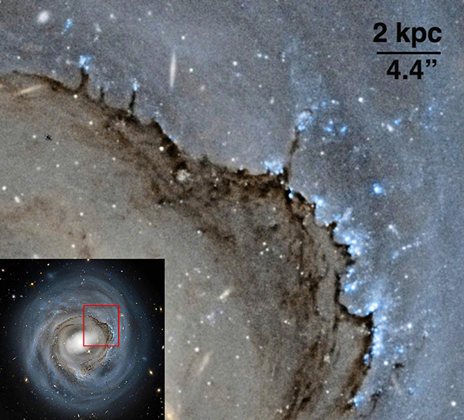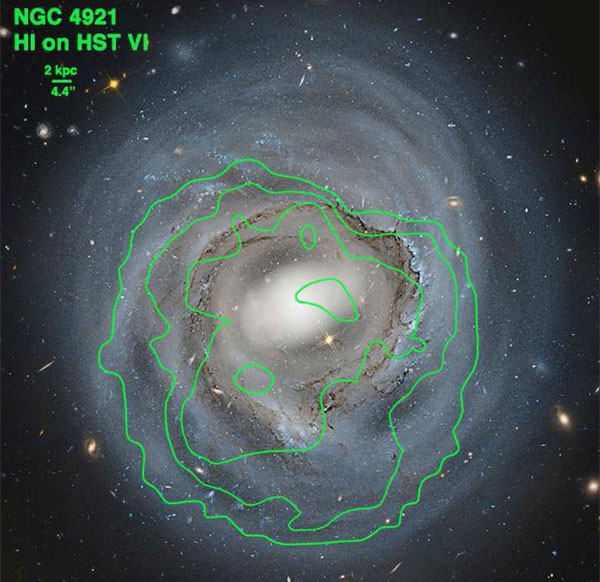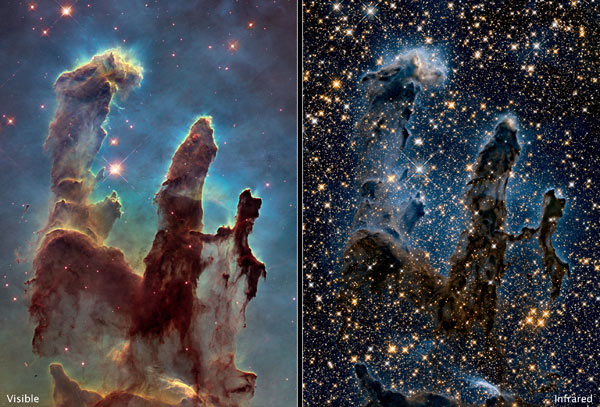Galaxy NGC 4921 faces an intracluster wind that's eroding its star-forming terrain.
On Earth, wind can transform entire landscapes. Turns out the same is true in space.

J. Kenney & others / Astronomical Journal
More than 1,000 galaxies swarm together in the Coma Cluster, the closest massive galaxy cluster. But it’s the intracluster medium, the gas, dust, and stars between the galaxies, that contains the bulk of the cluster’s mass (excepting dark matter). Galaxies passing through this sparse medium perceive it as a wind, and the wind reshapes the landscapes inside the galaxies.
For Coma’s biggest spiral galaxy, NGC 4921, whose gravitationally bound orbit is carrying it straight into the cluster’s center, that wind comes in from the northwest (from our perspective) and eats away at star-forming clouds of dust and gas inside the spiral.

J. Kenney & others / Astronomical Journal
Jeffrey Kenney (Yale University) and colleagues recently captured this wind’s erosion in Hubble Space Telescope and Very Large Array (VLA) images, as reported in the August Astronomical Journal. The VLA's observations reveal the large reservoir of neutral hydrogen gas in which NGC 4921 — like other galaxies — sits. But the hydrogen disk isn’t circular, as it would be if the face-on galaxy lived alone. Instead, it’s compressed on the northwest side, crushed inward by the intracluster wind. Hubble close-ups of the galaxy's northwestern side confirm that the wind that compresses the neutral hydrogen is also eroding all but the densest dust clouds in the spiral disk.

NASA / ESA / Hubble Heritage Team (STScI / AURA)
The whole northwestern structure looks very like the Eagle Nebula’s so-called Pillars of Creation (and like Bolivia’s Arbol de Piedra, a rock eroded by violent desert winds) — all three are products of erosion. But stars’ intense radiation is what eroded the gas cloud that gave us the Pillars of Creation, which are 5 light-years long. The wind-eroded pillars of NGC 4921, on the other hand, are 1,000 times larger.
Another force is likely at play in NGC 4921, too. The nearly linear dust pillars on the northwestern side are connected to a dusty front that runs about 65,000 light-years long, like an embattled line holding against the wind's onslaught. The fact that the densest globules are still connected perpendicularly to this filament, rather than breaking off like the globules in the Carina Nebula, suggests that something is helping to hold this gas together. Kenney’s team ran simulations that showed that the structures seen in NGC 4921 could only be reproduced if magnetic fields are affecting gas dynamics.
The wind faced by NGC 4921, technically known as “ram pressure,” is a force felt by most cluster galaxies, and it’s instrumental to their evolution. The wind strips away gas and dust, eventually quenching star formation and ushering galaxies from youth into old age. Just how this transformation happens still hasn’t been deciphered, but these high-resolution images will guide more detailed simulations in revealing the underlying process.
Reference:
J. Kenney et al. "Hubble Space Telescope and HI Imaging of Strong Ram Pressure Stripping in the Coma Spiral NGC 4921: Dense Cloud Decoupling and Evidence for Magnetic Binding in the ISM." Astronomical Journal. August 2015.
Celebrate 25 years of Hubble images and discoveries in our special June issue of Sky & Telescope.
 6
6
Comments
John-Persichilli
July 31, 2015 at 5:13 pm
Where did all that dust come from? Supernovae? Or some other mechanism.
You must be logged in to post a comment.
August 1, 2015 at 6:23 am
I realise that 'northwest' is purely a convenient descriptor, but the images seem to show the galaxy being 'squeezed' from the upper right quadrant. Have they been accidentally flipped?
You must be logged in to post a comment.
Monica YoungPost Author
August 3, 2015 at 9:59 am
Good question! East is left in sky maps and astronomical images. (See the "Directions and Distances" section in this article: http://skyandtelescope.org/astronomy-resources/using-a-map-at-the-telescope/)
You must be logged in to post a comment.
August 2, 2015 at 10:49 am
In the case of Arbol de Piedra, and the hoodoos that are found in other areas, there has to be a harder object at the top of the pillar to protect the underlying layers from rain erosion. (then horizontal wind takes care of the rest of the erosion). Looking at the first image of NGC4921 it would appear that there is a star at the top of each pillar, protecting it. Is that an accurate observation?
It's hard to see whether the Pillars of Creation have similar protection.
You must be logged in to post a comment.
Monica YoungPost Author
August 3, 2015 at 9:57 am
Actually, I think that Arbol de Piedra looks the way it does because it's sand-carrying wind that erodes the rock away. The wind can't lift the sand very high, so the top layers are less eroded.
In the case of the dust pillars, it's the densest gas that withstands the intracluster wind's eroding effects. Dense gas is very likely to be forming stars, so that's why you tend to see stars (particularly newborn stars) at the top of these dust pillars (this can be seen in the Pillars of Creation too).
You must be logged in to post a comment.
August 11, 2015 at 1:35 am
Thanks for the response Monica. i suspect we could have some interesting debates on those points!
You must be logged in to post a comment.
You must be logged in to post a comment.